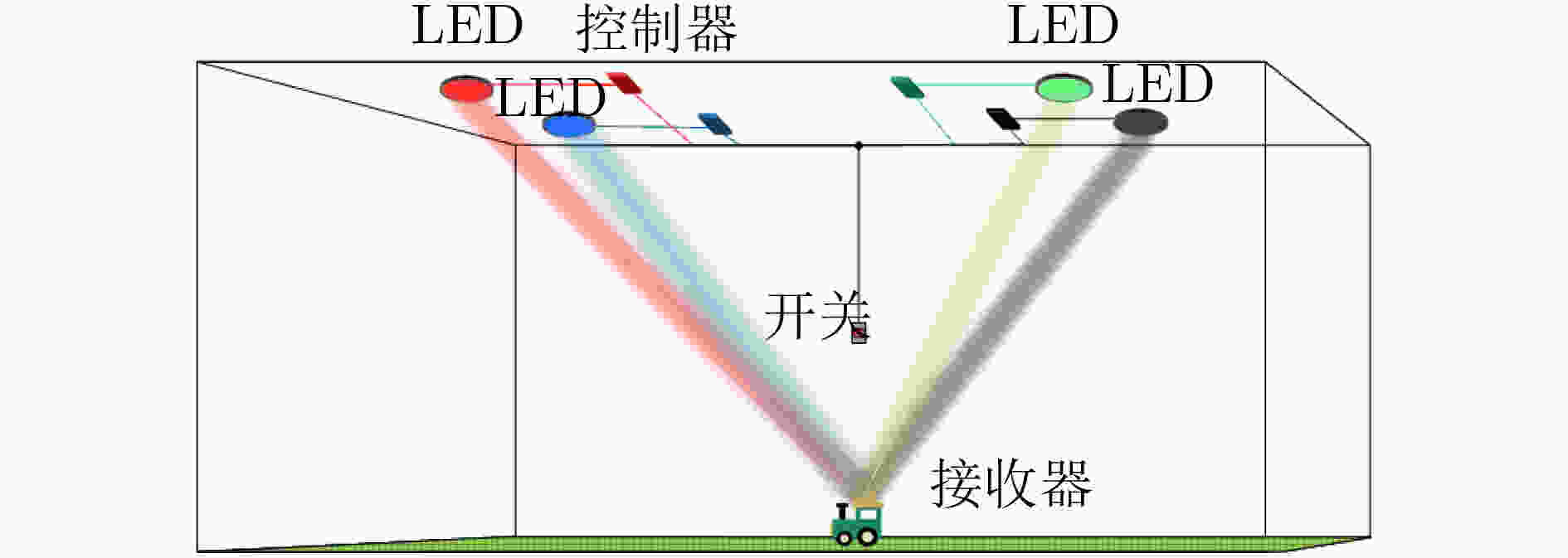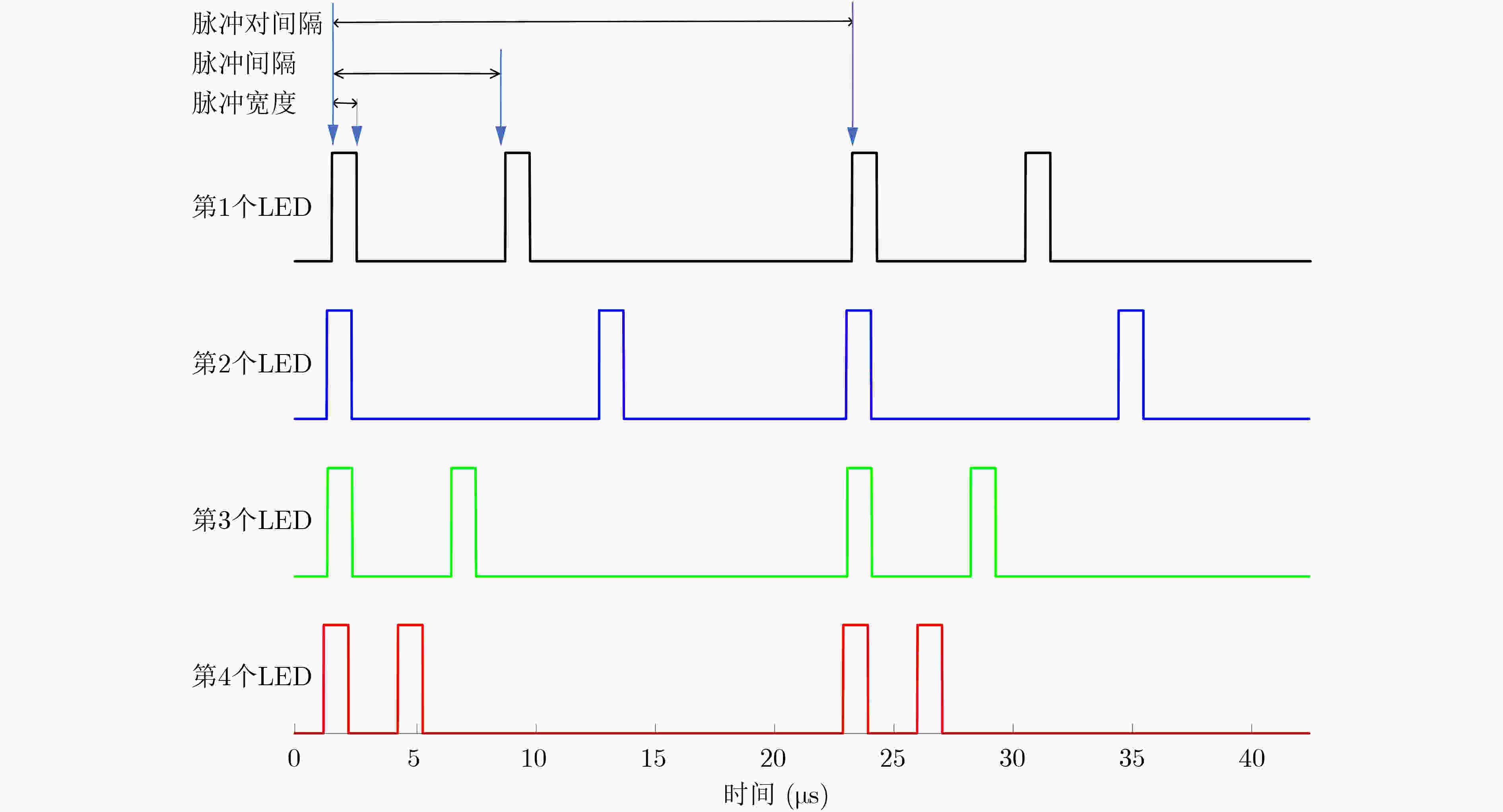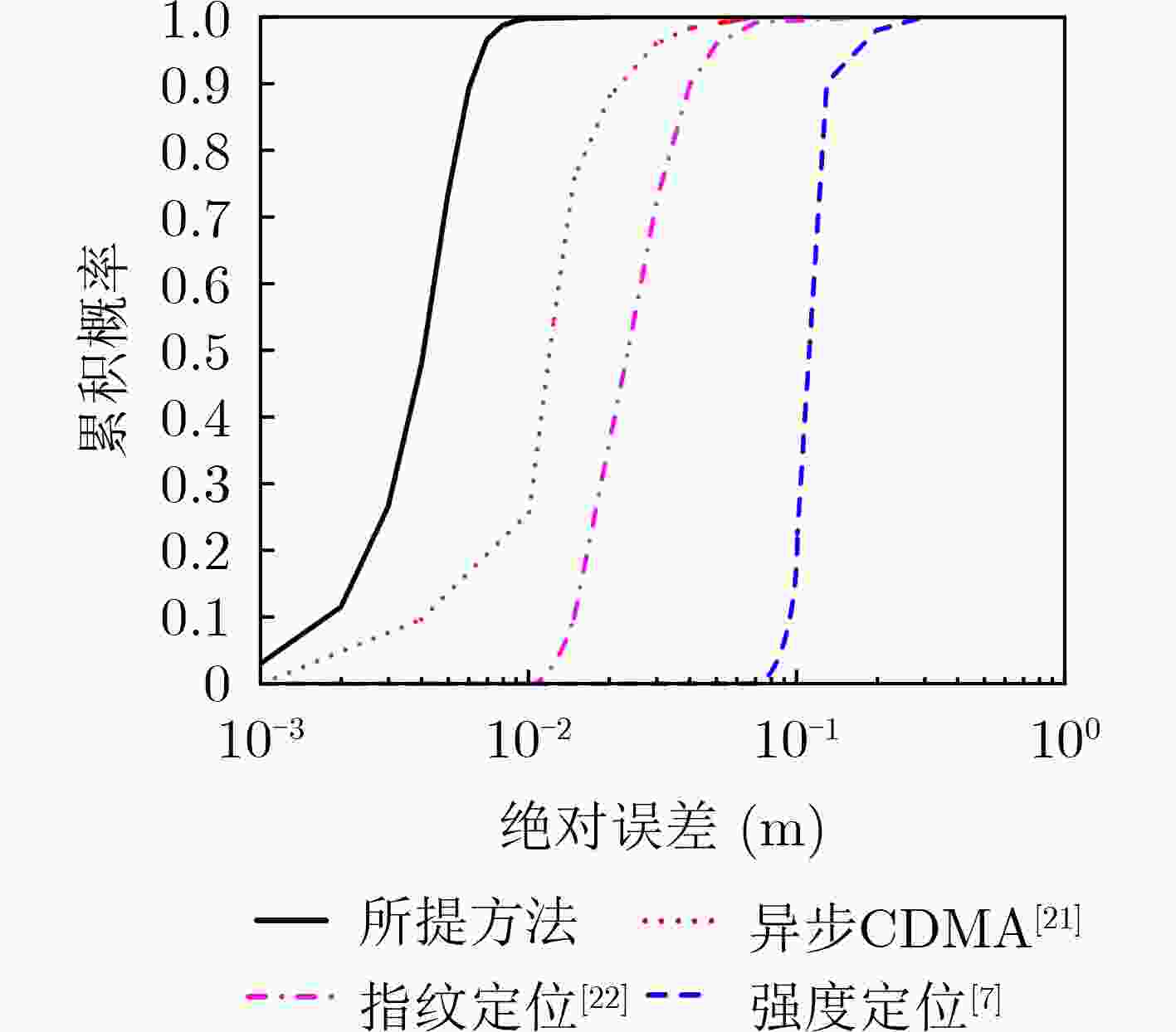An Asynchronous Visible Light Positioning Method Based on New On-Off Keying Coded Pulse-pair
-
摘要: 发光二极管(LED)照明的普及为高精度室内定位提供了一种绿色低成本的解决方案,作为最经济的LED调制方式,开关键控(OOK)由于开关速度、响应时间和节点间同步等的限制,存在定位精度差等问题。该文提出一种基于新型开关键控编码脉冲对的室内信标构造方法及其对应的异步可见光定位模型,各LED仅需按所提规则进行开关键控,光电探测器(PD)端可以获得最大后验概率准则下的最优位置估计。经验证,当信道(含LED和接收机)具有理想带宽、200 MHz和100 MHz带宽时,在30 dB的信噪比(SNR)条件下,终端以90%的概率使得定位精度分别可以达到6 mm, 7 mm和1 cm。在相同条件下,与异步码分多址(CDMA)进行定位、传统OOK基于指纹进行定位以及传统OOK基于接收信号强度进行定位这3种方法相比,该文提出的方法可以获得明显较好的定位效果。另外,当带内信噪比从30 dB恶化至15 dB时,终端的定位精度还能稳健地保持在厘米量级。Abstract: The popularity of Light-Emitting Diode (LED) lighting provides a green and low-cost solution for high-accuracy indoor positioning. As the most economical LED modulation method, On-Off Keying (OOK) has poor positioning accuracy due to the defects of switching speed, response time, and synchronization between nodes. In this paper, an indoor positioning beacon based on the new OOK coded pulse-pair and its corresponding asynchronous visible light positioning model is proposed. Herein, each LED only needs to perform OOK according to the proposed rules, and the optimal position of the PhotoDetector (PD) terminal under the maximum posterior probability criterion can be estimated. It is verified that when the channel (including LED and receiver) has ideal bandwidth, 200 MHz, and 100 MHz bandwidth, the terminal can achieve a positioning accuracy of 6 mm, 7 mm, and 1 cm with a 90% probability under the condition of 30 dB Signal-to-Noise Ratio (SNR). Under the same conditions, compared with asynchronous Code Division Multiple Access (CDMA) positioning, traditional OOK positioning based on fingerprint and traditional OOK positioning based on received signal strength, the proposed method in this paper can get a significantly better positioning effect. In addition, when the SNR deteriorates from 30 dB to 15 dB, the positioning accuracy of the terminal can also be robustly maintained in the order of centimeters.
-
Key words:
- Indoor positioning /
- Asynchronous visible light /
- On-Off Keying (OOK) /
- Coded pulse-pair /
- High accuracy
-
表 1 所提定位模型算法
(1) 设置位置误差容限$ \varepsilon $、脉冲宽度$ {T_w} $、脉冲对间隔$ {T_I} $、LED的坐标$\left( {x_i^{{\rm{Led}}},y_i^{{\rm{Led}}},z_i^{{\rm{Led}}} } \right)$、LED的辐射功率$ P $、参考位置的坐标
$\left( {x_0^{{\rm{Pd}}},y_0^{{\rm{Pd}}},z_0^{{\rm{Pd}}} } \right)$、时域搜索步进因子$ \alpha $。(2) 将终端固定在参考位置,开始检测脉冲,并对脉冲对计数$ k $,测量第$ i $个LED在第$ k $个脉冲对间隔内可分辨的脉冲${\boldsymbol{y}}_i^0\left( k \right)$及脉冲到达时间
${\boldsymbol{t}}_i^0\left( k \right)$,计算距离${\boldsymbol{d}}_i^0$及信道增益${\boldsymbol{h}}_i^0$:${\boldsymbol{h} }_i^0{\text{ = } }\dfrac{1}{ {K \times \sqrt P } }\displaystyle\sum\limits_{k = 0}^{K - 1} { {\boldsymbol{y} }_i^0\left( k \right)}$(3) 计算4个LED发射第$ 0 $组脉冲对的时间为:${ {\boldsymbol{\phi} } _i}\left( 0 \right) = \dfrac{1}{K}\displaystyle\sum\limits_{k = 0}^{K - 1} {\left( { {\boldsymbol{t} }_i^0\left( k \right) - { { {\boldsymbol{d} }_i^0}/ {\rm{c}}} - k \times {T_I} } \right)}$ 时间误差为:${\delta ^2} = \dfrac{1}{K}{\displaystyle\sum\limits_{k = 0}^{K - 1} {\left( {{\boldsymbol{t}}_i^0\left( k \right) - \left( { { {{\boldsymbol{d}}_i^0}/ c} + {{\boldsymbol{\phi}} _i}\left( k \right)} \right)} \right)} ^2}$ 4个LED的发射第$ k $个脉冲对的时间为:${{\boldsymbol{\phi}} _i}\left( k \right) = {{\boldsymbol{\phi}} _i}\left( 0 \right) + k \times {T_I}$ (4) 计算第$ i $个LED可能的发射时间集合:${ {\boldsymbol{\varPhi } }_i}{\text{ = } }\left\{ { { {\boldsymbol{\phi} } _i}\left( k \right) - 3\delta :{ {\alpha \varepsilon }/ {\rm{c} } }:{\phi _i}\left( k \right) + 3\delta } \right\}$
(5) 在集合${ {\boldsymbol{\varPhi } }_i}$中,计算似然比$ \gamma $:$\gamma {\text{ = } }\displaystyle\sum\limits_{k = 1}^K {\displaystyle\sum\limits_{i = 1}^4 {\left| { {{\boldsymbol{y}}_i}\left( k \right) - \sqrt {P \times {\boldsymbol{w}}_{ {\phi _i} }^s\left( k \right) \times {T_w} } \times {\boldsymbol{h}}_i^s} \right|} }$并剔除不满足式(9)约束的组合。(6) 找到$ \gamma $的最大值对应的${\hat {\boldsymbol{\phi}} _i}\left( k \right)$和$\hat {\boldsymbol{s}}$,分别为满足最大后验概率准则的发射时间和终端位置的最优估计。 表 2 算法验证参数
图3(a)、图4(a)、图4(c) 图3(b)、图4(b)、图4(d) 图5 信噪比(dB) 30 30, 20, 15 LED及终端带宽(MHz) 200, 100, 50 200, 100, 50 LED的数量 4 6 4 LED的坐标 [1.25 1.25 3; 3.75 1.25 3;
1.25 3.75 3; 3.75 3.75 3][1 1.5 3; 2.5 1.5 3; 4 1.5 3; 1 3.5 3; 2.5 3.5 3; 4 3.5 3] [1.25 1.25 3; 3.75 1.25 3;
1.25 3.75 3; 3.75 3.75 3]表 3 信标参数 (μs)
LED 1 LED 2 LED 3 LED 4 LED 5 LED 6 脉冲间隔 7 11 5 3 13 17 -
[1] 3GPPTS 22.261 V18.4.0[EB/OL]. https://www.3gpp.orglftp/specslarchive/22_series/22.261/, 2021. [2] CHOWDHURY M Z, HASAN M K, SHAHJALAL M K, et al. Optical wireless hybrid networks: Trends, opportunities, challenges, and research directions[J]. IEEE Communications Surveys & Tutorials, 2020, 22(2): 930–966. doi: 10.1109/COMST.2020.2966855 [3] 刘艳亮, 张海平, 徐彦田, 等. 全球卫星导航系统的现状与进展[J]. 导航定位学报, 2019, 7(1): 18–21,27. doi: 10.16547/j.cnki.10-1096.20190103LIU Yanliang, ZHANG Haiping, XU Yantian, et al. Development status and trend of global navigation satellite system[J]. Journal of Navigation and Positioning, 2019, 7(1): 18–21,27. doi: 10.16547/j.cnki.10-1096.20190103 [4] 宿晨庚, 郭树人, 刘旭楠, 等. 北斗三号基本系统空间信号质量评估[J]. 电子与信息学报, 2020, 42(11): 2689–2697. doi: 10.11999/JEIT190683SU Chengeng, GUO Shuren, LIU Xu’nan, et al. Signal quality assessment of BDS-3 preliminary system[J]. Journal of Electronics &Information Technology, 2020, 42(11): 2689–2697. doi: 10.11999/JEIT190683 [5] ZHUANG Yuan, HUA Luchi, QI Longning, et al. A survey of positioning systems using visible LED lights[J]. IEEE Communications Surveys & Tutorials, 2018, 20(3): 1963–1988. doi: 10.1109/COMST.2018.2806558 [6] KESKIN M F, SEZER A D, and GEZICI S. Localization via visible light systems[J]. Proceedings of the IEEE, 2018, 106(6): 1063–1088. doi: 10.1109/JPROC.2018.2823500 [7] GLIGORIĆ K, AJMANI M, VUKOBRATOVIĆ D, et al. Visible light communications-based indoor positioning via compressed sensing[J]. IEEE Communications Letters, 2018, 22(7): 1410–1413. doi: 10.1109/LCOMM.2018.2833550 [8] 吴楠, 王旭东, 胡晴晴, 等. 基于多LED的高精度室内可见光定位方法[J]. 电子与信息学报, 2015, 37(3): 727–732. doi: 10.11999/JEIT140725WU Nan, WANG Xudong, HU Qingqing, et al. Multiple LED based high accuracy indoor visible light positioning scheme[J]. Journal of Electronics &Information Technology, 2015, 37(3): 727–732. doi: 10.11999/JEIT140725 [9] JUNG S Y, HANN S, and PARK C S. TDOA-based optical wireless indoor localization using LED ceiling lamps[J]. IEEE Transactions on Consumer Electronics, 2011, 57(4): 1592–1597. doi: 10.1109/TCE.2011.6131130 [10] KESKIN M F and GEZICI S. Comparative theoretical analysis of distance estimation in visible light positioning systems[J]. Journal of Lightwave Technology, 2016, 34(3): 854–865. doi: 10.1109/JLT.2015.2504130 [11] KESKIN M F, GEZICI S, and ARIKAN O. Direct and two-step positioning in visible light systems[J]. IEEE Transactions on Communications, 2018, 66(1): 239–254. doi: 10.1109/TCOMM.2017.2757936 [12] DE ALBUQUERQUE V M, SOARES G M, ALONSO J M, et al. A simple resonant switched-capacitor led driver employed as a fast pulse-based transmitter for VLC applications[J]. IEEE Journal of Emerging and Selected Topics in Power Electronics, 2021, 9(1): 111–122. doi: 10.1109/JESTPE.2020.2965505 [13] NAWAZ T, SEMINARA M, CAPUTO S, et al. IEEE 802.15. 7-compliant ultra-low latency relaying VLC system for safety-critical ITS[J]. IEEE Transactions on Vehicular Technology, 2019, 68(12): 12040–12051. doi: 10.1109/TVT.2019.2948041 [14] IEEE. IEEE Std 802.15. 7-2011 802.15. 7-2018 IEEE standard for local and metropolitan area networks--Part 15.7: Short-range optical wireless communications[S]. New York: IEEE, 2019: 1–407. [15] SHI Jinwei, CHI Kailun, WUN J M, et al. GaN based Cyan light-emitting diodes with GHz bandwidth[C]. 2016 IEEE Photonics Conference (IPC), Waikoloa, USA, 2016: 623–624. [16] RAE B R, MCKENDRY J, GONG Zheng, et al. A 200MHz 300ps 0.5pJ/ns optical pulse generator array in 0.35µm CMOS[C]. 2010 IEEE International Solid-State Circuits Conference - (ISSCC), San Francisco, USA, 2010: 322–323. [17] HUANG Beiju and CHEN Hongda. A monolithic optical receiver chip for free space visible light communication system[C]. The 2012 IEEE 11th International Conference on Solid-State and Integrated Circuit Technology, Xi'an, China, 2012: 1–3. [18] SONG Xiaoqing, WEI Youcai, ZHAO Zixu, et al. The influence of driving current on the LED modulation bandwidth indoor VLC[C]. 2017 IEEE/CIC International Conference on Communications in China (ICCC Workshops), Qingdao, China, 2017: 1–6. [19] ABOU-SHEHADA I M, ALMUALLIM A F, ALFAQEH A K, et al. Accurate indoor visible light positioning using a modified pathloss model with sparse fingerprints[J]. Journal of Lightwave Technology, 2021, 39(20): 6487–6497. doi: 10.1109/JLT.2021.3098005 [20] ZHANG Ran, ZHONG Wende, QIAN Kemao, et al. A reversed visible light multitarget localization system via sparse matrix reconstruction[J]. IEEE Internet of Things Journal, 2018, 5(5): 4223–4230. doi: 10.1109/JIOT.2018.2849375 [21] 陈旭. 基于异步码分多址的室内可见光定位系统设计[D]. [硕士论文], 华中科技大学, 2018.CHEN Xu. Design of indoor visible light positioning system based on asynchronous code division multiple access[D]. [Master dissertation], Huazhong University of Science and Technology, 2018. [22] XU Ming, XIA Weiwei, JIA Ziyan, et al. A VLC-based 3-D indoor positioning system using fingerprinting and K-nearest neighbor[C]. The 2017 IEEE 85th Vehicular Technology Conference, Sydney, Australia, 2017: 1–5. -






 下载:
下载:







 下载:
下载:
